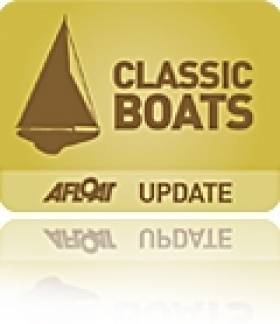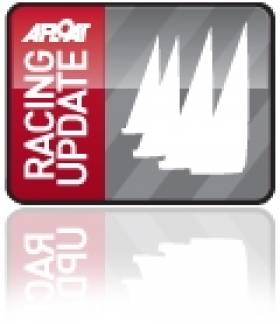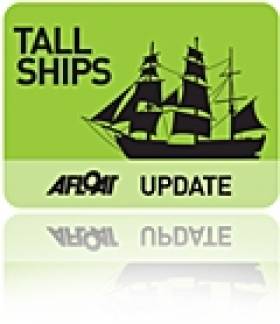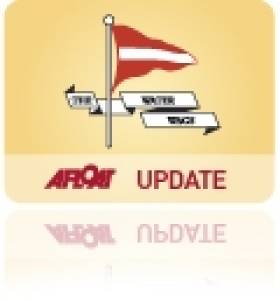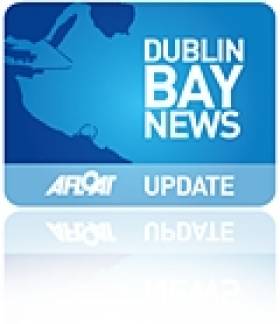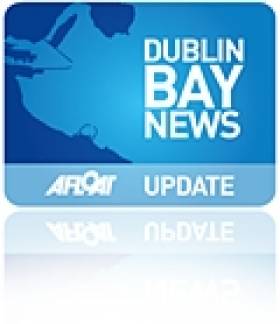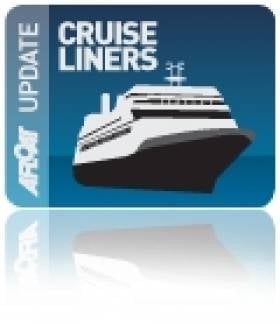Displaying items by tag: Dun Laoghaire
#ClassicBoats - An art conservationist is turning his hand to a restoration of a different kind - in the form of a vintage boat.
Simone Mancini, head of conservation at the National Gallery of Ireland, began work on restoring the hull of an old boat named Kara Third a couple of years ago.
And as the Dun Laoghaire Harbour Company website reports, he's now working on topsides for the hull that's now complete and looking as good as if not better than new.
"It has been a long enduring and rewarding process which required specific knowledge (here in big trouble) as much as passion (I was fine with it)," writes Mancini about his project.
"Talking to people who know a lot about this matter, necessarily becomes part of the process. Always told: it is a true labour of love, isn’t it?"
Though the Kara Third is a "work still in progress", it's remarkable to behold what an amateur in the boat restoration world has achieved thus far.
23 Water Wags Turn Out For 100th Anniversary Trophy Race
#waterwags – On 3rd June conditions were ideal for a Water Wag race within the full width of Dun Laoghaire Harbour, with a six–knot easterly breeze and warm Summer conditions. Unfortunately between the five minute gun and the start, the wind disappeared completely for the twenty three Wags racing for the 100th. Anniversary Trophy (division 1A) , and the historic pictures (division 1B and 2).
Some competitors realized that a new wind might come from the north-east and found space of the start line to tack onto port tack, and found a 'Get-out-of-jail-card'. They were Cathy MacAleavey's 'Mollie', Tim Pearson's 'Little Tern', William Prentice's 'Tortoise', Frank Guy's 'Gavotte', and Orla Fitzgerald's 'Eva'. This group found a light breeze which quickly took them away from the bulk of the fleet which was still floundering on the start line. The lead group rounded the first windward mark, and flew their spinnakers on the return to the leeward gate. On the downwind leg a new stronger breeze came in from the east which compacted the fleet; in particular Richard Mossop's 'Polly' was a beneficiary. By the time the fleet had reached the leeward gate for the third time the wind pressure went soft again, allowing 'Tortoise' to put pressure on 'Mollie.' However, the leader managed to defend her position. At the finish the positions were:
1st. Mollie, No. 41, Cathy MacAleavey & Con Murphy (winner division IA)
2nd. Tortoise, No. 42, William & Linda Prentice.
3rd. Little Tern, No. 36, Tim & Marcus Pearson.
4th. Gavotte, No.25, Frank Guy & Owen McNally.
5th. Pansy, No. 3, Vincent Delany & Noelle Breen.
6th. Sara, No.30, Paul & Ann Smith (winner division 1B)
7th. Good Hope, No.18, Hal Sisk & Sue Westrup.
8th. Swift, No.38, Guy Kilroy.
9th. Alfa, No. 12, Michael Donohoe.
10th. Vela, No.4, Brian Bond & Philip Mayne.
11th. Polly, No.31, Richard Mossop, (winner division 2.)
12th. Barbara, No. 8, Ian & Judith Malcolm.
13th. Penelope, No.16, Fergus Cullen & Alice Walsh.
14th. Maureen, No.23, Killian Skay & Liz Croxon.
15th. Scallywag, No.44, Dan O'Connor & David Williams.
16th. Freddie, No.43, David Corcoran & Bairbre Stewart.
17th. Ethna, No. 1, Bill Nolan.
18th. Chloe, No. 34, Kate O'Leary
19th. Sprite, No. 10, Adrian Masterson.
20th. Swallow, No.40, David & Anne Clarke.
21st. Marcia, No. 37, Ben McCormick
22nd. Eros, No. 08, Gail Varian & Gavan.
Retired, Nandor, No. 26, Harry Croxon & Stuart McBean.
#TallShips - Dun Laoghaire Marina has put out a reminder to watch for a special visitor to the harbour this coming Thursday 28 May in the shape of the tall ship Kaskelot.
The Baltic Trader, which dates from 1948, was converted to replicate a traditional barque for film and TV productions such as Return to Treasure Island and Shackleton, and later restored at Gloucester's historic docks.
More recently Kaskelot has been touring the British Isles for the summer season, departing Bristol on 14 March with stops in Plymouth, Poole, Weymouth and Fowey before a cross-channel jaunt to the Gulf of Morbihan in Brittany, then back north to Liverpool for the Sound City Music Festival, from where she sets sail to Dublin this week.
It's just a flying visit, though, as Kaskelot is due in Dartmouth on 6 June. The ship's official website has more HERE.
Teenage Powerboat Thieves Pursued By Gardaí
#BoatTheft - The Garda Air Support Unit gave chase to three teenagers on a stolen powerboat along the east coast yesterday (Sunday 24 May), as the Irish Independent reports.
The trio of thieves took the 40ft high-powered yacht from Dun Laoghaire Harbour some time after 5.30am and headed as far as Wexford before turning back towards Wicklow.
After they were spotted near Greystones after lunchtime operating the "incredibly powerful boat in a very reckless manner", they led gardaí on a dangerous chase putting many other coastal boat users at risk.
The Irish Independent has more on the story HERE.
Update: Wicklow News has images of the stolen boat being towed back to the marina by Dun Laoghaire RNLI.
#waterwags – The Water Wag fleet was back to full strength for the first of three handicap races for the Buckingham Cup (div. 1A+1B) and the Wigham Trophy (div. 2) on 18 May. The fleet who had travelled to France to compete in the classic boat event, La Semaine de la Voile du Golfe de Morbihan were back in Dun Laoghaire in time for the race.
Forty-one handicap times were allocated, and twenty-one Water Wags came to the start line. This race was organised as a pursuit race with a handicap start. The first three boats to start were Brian McBride and Stuart Mc Bean in the Michael Mahony built 'Nandor', Fergus Cullen and Alice Walsh in the Michael Mahony built 'Penelope' and Adrian Masterson and Geoff Davys in 'Sprite'.
The conditions were ideal with a shifty wind in Dun Laoghaire harbour of about 10 knots gusting to about 12 knots. The course was a windward leeward course of four and a half laps. It was five and a half minutes later that the last starters got away. The westerly wind enabled the whole width of the harbour to be used, and on the beats, competitors had the tactical choice of heading either towards the harbour mouth or to the HSS ferry berth. Because the wind was shifty, neither option was consistently beneficial. However, 'Nandor' took the harbour mouth option each time and it worked for them. Back through the large fleet of classic boats places were changing rapidly.
William and Linda Prentice in the John Jones built 'Tortoise' and Tim and Marcus Pearson in the Derek Paine built 'Little Tern' consistently made places both on the upwind and downwind legs. In fact 'Tortoise' was in 15th place on the first lap, 11th on lap two, 7th on lap three and finished in second place. A remarkable performance.
At the finish the places were:
1st. 'Nandor', Brian McBride and Stuart Mc Bean.(div.2).
2nd. 'Tortoise', William and Linda Prentice.(div. 1A).
3rd. 'Penelope', Fergus Cullen and Alice Walsh. (div.2).
10th. 'Eva' Orla Fitzgerald and Dermot O'Flynn. (div.1B).
#DunLaoghaire - A section of Dun Laoghaire's East Pier is at risk of structural failure and requires repairs at a cost of up to €5 million, according to an unpublished engineer's report obtained by RTÉ News.
Afloat.ie previously reported on the existence of the report, commissioned by the Dun Laoghaire Harbour Company, which it's been claimed highlights a number of issues across the south Dublin harbour's three main piers.
The biggest of these concerns a 75-metre section of the East Pier where the recently approved 'urban beach' project will be developed in time for the 2016 summer season.
Steel structural beams supporting Berth 1 on the pier are described as being "at risk of corrosion or failure".
The pier will not have to be closed while repairs are made, as the platform jutting out from the main pier into the harbour is still "completely safe", according to harbour master Simon Coate.
But the cost of repairs is expected to be anywhere between €1 million and €5 million.
RTÉ News has more on the story HERE.
#dharbour – RESPONSE TO PUBLIC COMMENTARY ARISING FROM STAKEHOLDER/PUBLIC CONSULTATION EXERCISE HELD IN MARCH/APRIL 2015 CRUISE BERTH PROJECT AT DUN LAOGHAIRE HARBOUR For DUN LAOGHAIRE HARBOUR COMPANY ON BEHALF OF THE DUN LAOGHAIRE CRUISE STAKEHOLDER GROUP
The Dun Laoghaire Cruise Stakeholder Group has responded to concerns raised in a number of submissions made as part of an informal pre-planning consultation process in connection with the proposed development of a new cruise berth facility in Dún Laoghaire Harbour.
It is expected that a formal planning application for the proposed development will be submitted to An Board Pleanala in the coming weeks.
As part of the consultation process the Cruise Stakeholder Group met and briefed local public representatives and stakeholder groups. Full details of the proposal were posted on the Dún Laoghaire Harbour Company website and all those on the company's database were written to. Posters were also erected in the harbour area inviting members of the public to submit their views.
A total of 139 submissions were received. The submissions offered a variety of views, including positive support for the project. A large number of submissions expressed some concerns, and indeed opposition to the project. In some cases opposition / concern was based on a misunderstanding of what was actually proposed or had misplaced concerns about the implications for harbour users.
The Dún Laoghaire Cruise Stakeholder Group is committed to taking into account all submissions made before the planning application to An Bord Pleanála is finalised.
However, in order to address concerns that were raised, the Stakeholder Group has now published a short document summarising the main issues which arose during the informal pre-planning consultation process, along with a succinct response to each issue. A summary of the issues and responses will also available on the Harbour Company's website. This document is now being issued to all those who made submissions, to public representatives and to stakeholder groups. [Scroll down to read this document]
The Dun Laoghaire Harbour Masterplan, published in 2011, identified the need to develop strategies to ensure the long term future of the harbour, in view of the declining importance of ferry traffic. Development of cruise business was identified as one of the opportunities to be pursued. In addition, Dún Laoghaire is designated as a marine tourism port under the Government's National Ports Policy and the development of the cruise business fits into this framework.
Dún Laoghaire will have its most successful cruise season ever in 2015, with 100,000 passengers and crew expected. However the development of the cruise berth facility is essential to allowing up to build on the success to date and to bring even more vessels and passengers to our town.
The expansion and development of the cruise business offers significant economic benefits to Dún Laoghaire and the surrounding areas. These would include expenditure by disembarked passenger and crew; payments to tour operators by cruise companies and purchases by cruise ships from local supplies while in harbour.
The Dún Laoghaire Cruise Stakeholder Group is confident that the cruise berth development can be delivered while preserving the unique heritage of the harbour and without impacting unduly on sailing and marine leisure activities which are such significant parts of the harbour's activities.
Introduction
The Dun Laoghaire Harbour Company on behalf of the Dun Laoghaire Stakeholder Group in the process of compiling a planning application to be submitted to An Bord Pleanala under the Strategic Infrastructure (SID) provisions of the Planning & Development Act 2000, as
amended.
As part of that process it was decided to canvass the views of local people prior to making the planning application in order to seek to accommodate or ameliorate any issues that may arise as part of the application. This was referred to as a 'Phase 1 Consultation'.
The undertaking of this exercise and any involvement in same would not affect people's rights to participate in the planning application process in the normal way.
Phase 1 Consultation
A presentation was prepared in order to provide an over view of the project in terms of what it involves (both during construction and operation), the work undertaken to date and an explanation of the application process that would follow.
A set of Frequently Asked Questions (FAQ's) and responses was prepared in anticipation of the typical queries that would arise.
A page on the Harbour Company web site was set up which included the above presentation, together with accompanying maps of the harbour, along with the FAQ's. This information was available for download.
It was intended to have a two week period in which members of the public could make their views known. The Harbour Company used its database of stakeholders to send a letter inviting participation in this Public Consultation phase. In addition, posters were erected around the Harbour so that Harbour Users would see the consultation was on-going and could participate.
Prior to commencing this Consultation, meetings were arranged with key stakeholders/Harbour Users. These meetings took place in the last week of March 2015.
Overall, the Stakeholder/ public consultation process occurred over a three week period. There have also been a series of meetings both with Dun Laoghaire Rathdown County Council and An Bord Pleanala relating to this project. Those consultations occurred separately to this public consultation process.
Who did we meet?
The following is a schedule of the meetings held prior to the Public Consultation process
commencing:-
Monday, 23rd March:
• Dun Laoghaire Area Committee, Dun Laoghaire Rathdown County Council
Tuesday, 24th March:
• St Michael's Rowing Club
• Sea Scouts/ Kyron O'Gorman
• Irish National Sailing School
• Dun Laoghaire Motor Yacht Club
• Royal National Lifeboat Institution (RNLI)
Wednesday, 25th March:
• Coal Harbour Users Group
• Marina Company
• Dun Laoghaire Business Investment District Company
• Commissioners of Irish Lights
Thursday, 26th March:
• National Yacht Club
• Dublin Bay Sailing Club
Friday, 27th March:
• Royal Saint George Yacht Club
• Royal Irish Yacht Club
Wednesday 1st May 2015
• The Water Wags
Number of responses
In total 139 responses were received during this Phase 1 Consultation phase. Of these, 13 were in favour of the project, 22 made observations or raised queries and the remainder were against, with a variety of issues raised.
In general only a minority of submissions were supportive, some simply raised questions of made broad comment, but the majority expressed opposition to the proposal; in some cases these were based upon a misunderstanding of what was in fact proposed, or misplaced about the implications for harbour users.
What were the issues raised?
In seeking to provide a response at this stage, we have attempted to group common issues under particular headings. This avoids too much repetition in the responses provided below.
From a review of the Submissions made, the following issues arose:-
1. Impact on dingy sailing/youth sailing
2. The cruise berth cuts the harbour in two.
3. Impact on sailing competitions in the harbour
4. Impact on ability to attract International sailing competitions
5. "Wind shadow" effect of cruise ship in harbour
6. Impact on Heritage of the harbour
7. Suitability (or otherwise) for a Victorian harbour
8. Potential for environmental damage and negative impact on bird and marine life
9. Safety/emergency incident plan
10. Rocky nature of harbour bed making dredging difficult
11. Disturbance to mercury in the harbour bed caused by dredging
12. No economic benefit to the town
13. Impact on traffic
14. Legal advice that project is not Strategic Infrastructure Development
15. Too little detail provided about the scheme
16. Consultation period too short
17. Replacement ferry service for Stena
18. Leave cruise business to Dublin Port.
19. Continue with existing cruise tendering operation (ships anchoring in Dublin Bay)
20. DLHC should not be allowed embark on a new venture like this, while a merger with DLRCoCo is pending
Dinghy sailing/youth sailing
It is evident from a review of the comments received that the issue which arose the most often was the impact the proposal would have on Dinghy Sailing/Youth Sailing. In particular, the following activities were raised:-
• Junior Summer Sailing Courses
• Sailability Dun Laoghaire
• Friday Night Racing
• September Series
• Regional and National Optimist Class Championships
• Junior Sailing Regatta's
• ISA National and Regional squad clinics
• Team Racing
• Winter Frostbite Racing
• Summer Tuesday Night Racing
• Winter Coaching
• Dun Laoghaire Regatta
We will have regard to the aspects associated with each of these within the planning application.
Preliminary response to issues
The issues raised through the public consultation exercise will be addressed in a full and comprehensive way as part of the plans and particulars to be lodged with An Bord Pleanala.
At the outset, it is worth recalling that Dun Laoghaire Harbour is first and foremost a working harbour. It also happens to accommodate a marine leisure component which it is recognised and acknowledged contributes to its charm and character. It is also recognized that the marine leisure component of the harbour is a significant part of the harbour activity. This marine leisure activity must and does function in a manner that does not detract from the primary function of the harbour.
To that end, it is worth highlighting that activities within the Harbour are carefully managed and controlled in line with long established rules, referred to as the Notices to Mariners and the Harbour Bye-Laws.
With that in mind, the following provides an initial response to the principal issues raised by members of the public and harbour users generally.
1 Impact on dingy sailing/youth sailing
At present, most harbour users ultilise the harbour as a transit zone between the shore and the bay, where the vast majority of sailing activities occur. This occurs in line with the normal restrictions applying within the Harbour. It is acknowledged that traditionally junior training has taken place in the harbour. All such activity requires the approval of the Harbour Master.
The Notice to Mariners No. 4 defines the Training Area for junior sail training. It states:- "Harbour Recreational Area for Small Craft is the triangular area of the North Bightwestwards of a line from West Pier Lighthouse to the marina west breakwater". Use of the remainder of the harbour by small craft is otherwise restricted, unless and until 'permission' has been obtained. With the removal of swing moorings in 2014, the North Bight area available for raining has been considerably enlarged which has benefitted junior training in the harbour. This will be unaffected by the proposed cruise project
Notwithstanding the Notice to Mariners No. 4, it is recognized that the very junior sailors/beginners associated with the NYC and RSGYC have utilized the sheltered water space immediately around the Carlisle Pier and St. Michael's Pier to learn to sail. Both the IYSC and the INSS use the designated training area at the North Bight.
When competent, the junior training regime then moves from around the piers, to the formal training area and then out to the bay. The INSS use both the Coal Harbour and Seapoint Beach, as well as using the designated training area.
The tradition over the past 15 years or so has been that the more senior/experienced juniors use Dublin Bay itself to train.
It is Dublin Bay that is the 'Major Area of Excellence for Sailing' and the sailing areas that are available now will be available after any cruise berth project has been installed. The designated training area in the North Bight has recently (2014) been extended and will continue to be available.
It has been suggested in a number of submissions that the provision of the cruise berth will prevent the harbour being used for sailing and other marine activity. This argument does not stand up to closer scrutiny. Whilst it is fully acknowledged that the facility will result in some change to the existing patterns of activities for some users, others will see little or no change.
Traditionally, there has been very little 'racing' inside the harbour, other than by the Water Wags, DBSC and the DMYC Winter Series and this has been 'by permission' only.
2 The cruise berth will cut the harbour in two The cruise berth will extend northwards from the existing marina breakwater, from a location to the west of the existing HSS berth.
Even though the berth structures are significant, to allow the berth to accommodate the type of large cruise ship that the cruise lines now favour, there will be a considerable expanse of water within the harbour, north of the northernmost extremity of the proposed berth, which will allow unimpeded travel for boats between the eastern and western areas of the harbour. The total distance from the marina breakwater to the West Pier roundhead is about 0.66 kilometers (660m). The berth will extend northwards for just under two thirds of this distance, leaving just over one third remaining for cross harbour activity.
In addition to the above, the proposed berth will include an underpass which will allow passage between the marina and the areas to the east of the harbour without the need to go around the berth. This underpass will be suitable for use by ribs, launches and other small non-masted craft.
3 Impact on sailing competitions in the harbour There are in fact only a very small number of sailing competitions in the harbour and these occur at particular times of the year only.
As previously noted, all activities within the harbour are subject to an approval process. It is considered that with the adjustments made to the swing moorings at the East and North Bights in recent years that it should be possible for these limited competitions to continue to use the harbour. The Harbour Company is committed to working with the race organisers to find a viable solution within the Harbour.
4 Impact on ability to attract international sailing competitions At the outset we would comment that when international sailing competitions have occurred in Dun Laoghaire in the past, this has imposed severe restrictions on other harbour users.
Appropriate restrictions and safeguards were put in place by the Harbour Master and harbour users adjusted their activities accordingly with little or no fuss for those periods. As regards the loss of such competitions due to the cruise berth project being implemented, it is respectfully submitted that this would not be the case. The continued use of the harbour as a transit zone and holding area as occurred with such events in the past could continue to occur when the cruise berth is in place.
5 Wind shadow effect of cruise ship in harbour Large cruise ships at berth will have an effect on the wind patterns locally, and will result in "wind shadow" downwind of the ship.
The affected area will vary depending on a number of factors, including the size of the ship, the direction of the wind and the speed of the wind. No matter what direction the wind is blowing, there will always an area of the harbour that will be windward of ships at berth and therefore unaffected. This unaffected area of the harbour will always be available for dinghy/youth sailing. It will also be possible to sail in the area affected by "wind shadow" on the leeward (sheltered) side of the ship, with the exception possibly of up close to the ship. Winds blowing roughly parallel to the ship will have little or no "wind shadow" effect. Experienced sailors are familiar with the "wind shadow" effect as their sails create "wind shadow" and a knowledge of this effect is used to gain competitive advantage in racing by manoeuvring to put their competitors in the bad wind caused by the "wind shadow" of their boats.
6 Impact on heritage of the harbour
The development being proposed does not impact on any protected structures, nor does it involve the removal of any heritage structures. The proposal involves the provision of a new berth within an existing harbour and is entirely appropriate as a result. It is acknowledged that part of the Harbour's heritage is its use for marine recreational purposes. This aspect of the Harbour use will not be destroyed by the cruise berth.
7 Suitability of proposal for a Victorian Harbour
There have been quite a number of changes to the activities that occur within the harbour since the days it was first built. The harbour has evolved many times as a result. As already highlighted, it is a working harbour. It is a simple fact that it costs a significant
amount of money annually to just maintain the quality and infrastructure of the harbour. Much of the harbour is old and needs on-going maintenance. The Harbour Company is self financing and needs to generate the required income to sustain the harbour in to the future. For clarity, the Harbour Company receives no funding from Government. The cruise berth is precisely the type of facility one would expect to find in a harbour. With the impending demise of the HSS (which has now occurred), the Harbour Company is looking to attract cruise ships to the harbour. The berth will go some way towards ensuring the viability of the harbour in to the future.
8 Potential for environmental damage and negative impact on bird and marine life This particular issue has been extensively assessed as part of the Environmental Impact Statement being finalized at present.
The preparation of this assessment involved extensive discussions with the National Parks and Wildlife Service, including the Marine Department in Galway and has been conducted by a firm of specialist ecologists. We have been concerned from the outset to minimize any impact the proposal might have on birds or marine life generally and have devised a construction methodology specifically intended to address this.
9 Safety/Emergency Incident Plan
As a working harbour, we can confirm that Dun Laoghaire Harbour has an Emergency Management Plan in place at present in line with the tenets of "A Framework for Major Emergency Management". The current Emergency Plan can be adjusted to take account of the cruise berth facility. The Plan already caters for cruise ship tendering. A Risk Assessment and SOP are in operation for present cruise visits and will be adapted for berth usage.
10 Rocky nature of harbour bed making dredging difficult
As part of the preparatory investigation and survey work undertaken for the project, a programme of ground investigation work was undertaken which included the drilling of boreholes into the seabed in the areas where the proposed berth would be constructed and in the areas to be dredged. It was found that rock was generally located well below the existing seabed and the proposed dredge level. It is therefore not envisaged that any rock or hard material will need to be dredged for the project. This is consistent with the findings of previous investigations in this area of the harbour.
11 Disturbance to mercury in the harbour bed caused by dredging
The area which will require dredging has been the subject of extensive ground investigations as part of the scheme design and Environmental Impact Statement process relating to the project. No elevated levels of mercury have been identified We are aware that mercury has historically been found in other parts of the Harbour near the Coal Harbour. No dredging or marine works are planned for the Coal Harbour as part of this project and as a result no disturbance to the ground conditions will arise.
12 No economic benefit to the town
The Stakeholder Group has commissioned a firm of economic consultants to look in to the economic impacts of the project. Their findings show that there is the very real potential for the town to benefit directly and significantly from the arrival of cruise visits to Dun Laoghaire.
It is estimated that the net economic impact of doing the project for Dun Laoghaire town will lie between €16m and €41m after twenty years, depending on the number of vessels coming into Dublin Bay. The lower number assumes a continuation of historical growth trends in the Dublin Bay market, while the upper limit represents a replication of the success of Copenhagen.
It is recognized that the businesses of the town need to embrace the potential for additional revenue arising from the visiting cruise passengers for this process to be a success. The Cruise Stakeholder Group are confident that Dun Laoghaire will maximize this potential in the years to come.
13 Impact on traffic
The traffic associated with the planned cruise project has been assessed as part of the Environmental Impact Statement process. This shows that the surrounding roads and streets are capable of catering for the traffic associated with the project with relative ease. The project will involve a modest number of coach trips at particular peak periods in the day.
Previously when the HSS was operating five sailings per day (arriving and departing), there was significantly more traffic movements in the area of the project.
It is also worth recalling that there was no particular traffic difficulties with the cruise visits to Dun Laoghaire last year and again when the Royal Princess visited Dun Laoghaire on the 12th May 2015 (3,600 passengers and 1,350 crew). Overall, we are confident that the traffic associated with the cruise project can be catered for
on the existing road network with minimal disturbance.
14 Legal advice that project is not Strategic Infrastructure Development
The project contains a new cruise berth that is greater than 100m in length capable of catering for the new generation of cruise vessels. The Seventh Schedule of the Planning & Development Act 2000, as amended includes a project involving a new berth in a harbour of 100m or more in length as being a project for which the provisions known as strategic infrastructure applies. In line with the requirements of the Act a dialogue with An Bord Pleanala to determine whether the project is or is not strategic infrastructure was commenced in May 2013. An Bord Pleanala have now confirmed in writing that the project is strategic infrastructure and have directed the planning application to be made to An Bord Pleanala directly.
15 Too little detail provided about the scheme
We would respectfully suggest that a significant amount of detail regarding the project was provided at pre-consultation and as part of the consultation. The final project design is nearing completion, as is the EIS that is intended to accompany the application. The outcome of this pre-application public consultation will feed in to the final plans. The full and final detail of the scheme will be available for interested members of the public on a dedicated web site and will also be available at the offices of Dun Laoghaire-Rathdown County Council during the seven week consultation period after the planning application is lodged with An Bord Pleanala. The application will also be available in the offices of An Bord Pleanala.
16 Consultation period too short
The stakeholder/public consultation period took place over a three week period. This was considered adequate to obtain the views of people towards the project. It was made clear in the material provided at this stage of the process that a further much lengthier and formal process of consultation would follow once the planning application for the project was lodged.
The response to the request for comments generated 139 submissions. There will be a full seven week consultation period once the planning application is lodged, during which time observations to An Bord Pleanala may be made. This will afford interested parties with a further opportunity to comment on the final proposals.
17 Replacement ferry service for Stena HSS
We can confirm that the Harbour Company is in discussion with potential ferry operators. Were a ferry service to return to Dun Laoghaire, it would only be a small craft service catering for small numbers of cars and foot passengers. It is not envisaged that by the operators that vessels capable of accommodating freight traffic will come to Dun Laoghaire again. Such a small craft ferry could operate in the harbour in tandem with a cruise berth facility.
18 Leave cruise business to Dublin Port
The National Ports Policy (2013) identifies Dun Laoghaire Harbour as follows:- the long-term future of Dún Laoghaire Harbour Company will be in terms of marine leisure, maritime tourism, cultural amenity and urban redevelopment. The cruise industry will have a major part to play in the realization of these national policy
aspirations for the harbour. It is considered entirely consistent with National Ports Policy to encourage cruise visits to Dun Laoghaire Harbour. It is considered that there is scope for both Dun Laoghaire Harbour and Dublin Port to cater for the increasing cruise industry in Dublin Bay.
19 Continue with existing cruise tendering operation (ships anchoring in the Bay)
Cruise lines will always favour direct berthing to tendering, as it offers a better experience for its passengers and is more reliable. Tender berthing requires a long transit from ships anchored a couple of kilometres outside the harbour in small tender boats. The transit time to and from the ship means that the time available for passengers ashore is shorter than would be the case if the cruise ship were able to berth within the harbour. It is also subject to weather conditions, as conditions may be such that the journey in the tenders is uncomfortable due wind and wave conditions, or indeed, weather conditions are such that it is deemed unsafe for passengers to disembark from the cruise ship onto the tenders, so the visit to Dun Laoghaire is cancelled. A smaller proportion of the passengers and crew on board the cruise ships will come ashore if the ships tender in Dublin Bay than if the ships berth in the harbour and passengers can disembark onto a quay. The provision of a direct berth will attract a greater number of cruise ships, and a greater proportion of passengers aboard those ships will come ashore to explore Dun Laoghaire and its surroundings, as it is easier to come ashore and to get back onto the ship, providing a greater benefit to Dun Laoghaire and
the greater Dublin area.
20 DLHC should not be allowed embark on a new venture like this, while a merger with DLRCoCo is pending
The project promoter is the Dun Laoghaire Cruise Stakeholder Group. The three principal members of this Group are; Dun Laoghaire Harbour Company, Dun Laoghaire-Rathdown County Council and the Dun Laoghaire BID Company.
The planning application is being made with the approval and assistance of Dun Laoghaire- Rathdown County Council which approved the initial expenditure at a Council Meeting in July 2013. Officials from Dun Laoghaire-Rathdown County Council have attended the majority of the project meetings held with An Bord Pleanala and have expressed their support in principle for the project.
#DunLaoghaire - Dun Laoghaire's 'urban beach' proposal has finally been approved by An Bord Pleanála months after a last-minute appeal against the scheme.
Originally greenlit by planners late last year, the project – modelled after Berlin's famous Badeschiff – faced a fresh objection in the weeks after that approval, amid local concerns over potential damage to the East Pier where its set to be installed.
Charges for use of the facilities were also an issue, as The Irish Times reports, with People Before Profit councillor Melisa Halpin decrying Dun Laoghaire-Rathdown County Council's fast-tracking of such high-profile projects over smaller schemes "such as a path through a field".
The urban beach scheme, now costed at some €2.75 million, will be co-funded by the council and the Dun Laoghaire Harbour Company, which recently lost board member Pam Kearney over concerns regarding it and other "cornerstone projects" of the harbour's master-plan.
#inss – Last week, Sailing on Saturday featured the Royal Cork Yacht Club, the oldest in the world, as it comfortably donned the mantle of the ISA/Mitsubishi Motors Sailing Club of the Year 2015. This morning, we find ourselves involved with what may well be the newest sailing club in the world, the Irish National Sailing Club. It is certainly, thanks to being inaugurated nearly three months after Youghal SC was founded on 28th October 2014, the newest in Ireland. W M Nixon tries to explain it all as he finds himself in the world of Irish sailing's most complete dynamo.
Alistair Rumball is a Life Member of the Awkward Squad. Cage-rattling and pot-stirring are second nature to him. But it's not because of experiencing an unhappy childhood. On the contrary, while growing up in Malahide, his boyhood summers were bliss. He and his brother Arthur had as much sailing as they could want, fitted in between part-time jobs raising pocket-money with a morning picking potatoes at Dermot Dickie's farm along the Broadmeadow Estuary, followed by an afternoon of sailing the sea with the sun always shining, and then maybe an evening of club racing followed by the easy camaraderie among kids who are comfortable with boats.
It was an idyllic maritime environment which, over the years, has produced some of Ireland's top racing and cruising sailors. But while the young Rumball was no slouch on the race-course, the strongest feeling he had about sailing was the sheer fun of it all, the totally absorbing wonder of being in a boat and hauling on ropes to make sails change shape and help you along your chosen course over the always interesting sea.
Although he graduated from Trinity College Dublin as an engineer, he increasingly had this almost evangelical attitude to spreading the good news about the fun of sailing. And while he has something of a reputation – to say the least - for being confrontational, it's central to his contradictory character that he's an extremely good teacher. If somebody shows the slightest genuine enthusiasm about wanting to learn to sail, Alistair Rumball has been prepared to go to endless lengths to teach him or her to do so, and to do so with enjoyment.
Underlying that, we find the first of his gripes about the modern sailing scene. He reckons that it has become far too serious. Don't think for a moment, though, that he believes in a frivolous approach to boats and sailing. He's deadly serious about having everything just right as regards safety and function.
But once that's sorted, then he firmly believes that you should go out and enjoy it. He waxes lyrical about moments of sheer sailing ecstasy he has enjoyed in a wide variety of boats in many sailing locations worldwide. And whatever he may have formally set out to be in a professional career, his working life has been spent in and around boats, getting people introduced to boats and out afloat, sometimes on an almost industrial scale.
Time was when sailing skills were something you acquired by a sort of osmosis through family tradition, club opportunities, and friendship examples. That's mostly how Rumball himself learned to handle a sailing boat. But he seems to have this almost messianic zeal to teach people to sail, and he became convinced that the future lay in more structured training with a proper syllabus.
Having taken a long hard look at the population distribution of the Greater Dublin area and where they might best get afloat in worthwhile numbers, in 1978 he acquired the assets of a moribund organisation, the Dun Laoghaire Sailing School, and soon found himself giving his first lessons to two pupils using a fibreglass-clinker Darragh 14 knockabout sailing dinghy which they'd launched from the public slipway in the Coal Harbour in Dun Laoghaire. The long journey had started towards an organisation whose activities today today include top-of-the-line race training in 1720s in winning mode:
The majestic granite harbour of Dun Laoghaire was a cold place in 1978 for any young enthusiasts trying to set up an independent sailing school on a commercial basis. For the powers that be, sailing was something to be learned through family and clubs under the Junior Training Programme of the Irish Yachting Association. If you were a young person or adult from a non-sailing background but keen to learn, unless you'd an obliging and patient friend from within the sailing establishment, the expectation was that you'd take yourself off to somewhere far away like the Glenans Ireland bases in Baltimore and Bere Island and Clew Bay, and eventually reappear after a decent interval with enough experience, newfound ability and contacts to make the grade in the Dublin Bay sailing scene, where the very thought of a raw in-harbour sailing school for outsiders seemed distasteful to the establishment.
Yet hidden away in the southwest corner of Dun Laoghaire harbour, here was this gadfly of the sailing scene, Can–do Alistair with his rough and ready sailing school enthusiastically recruiting pupils anywhere and everywhere, and taking them afloat in boats which may not have been in the most pristine condition, and certainly set sails which would not be winners on the race course, yet they were safe and able, and so were he and his instructors.
Over the years, an entire cohort of people, mainly from Dublin but also from all over Ireland with a useful smattering of pupils from abroad, came to boats and sailing thanks to this wild-haired character whose love of his demanding work shone through everything he did.
Gradually the fleet expanded, and so too did the "Rumball Group's" activities, even though the very limited availability of premises on the Dun Laoghaire waterfront meant that every little square foot they had always seemed to serve at least three different purposes. But they were getting there, they opened a retail outlet in the town to sell boat gear and equipment which became Viking Marine, the school promoted itself to being the Irish National Sailing School, and they were well settled in place, using every inch of space on the ground floor of the interesting little building on the southwest corner of the harbour which used to be the Nautical College.

The man and his machines – Alistair Rumball and his chariot outside the Irish National Sailing School's HQ in Dun Laoghaire. Photo: W M Nixon
Centuries ago, seafaring education was given a significant role in Irish life in the late 1700s, the 1800s, and the early 1900s with the old Marine School a fine building on the south quays in Dublin. But its premises were re-allocated for development purposes and the school itself had its final home in Clontarf before being absorbed only as a vague memory into what is now Mount Temple Comprehensive school.
These days, the marine education focus has moved to Cork with the fabulous new National Maritime College in Ringaskiddy, but for that low period in Irish maritime life in the mid 20th century, one of the few keepers of the flame was Captain Tom Walsh who operated the little Nautical College in this fairly inconspicuous Office of Public Works building now hidden away behind the Dun Laoghaire Motor Yacht Club.

Captain Tom Walsh in teaching mode in 1957 in the INSS building when it was the Nautical College.

The 110ft barquentine which Jack Tyrrell designed for Captain Tom Walsh's Nautical College in 1954 in the hope that it would inspire the building of an Irish Tall Ship
It was the gallant Captain Walsh who in 1954 commissioned Jack Tyrrell of Arklow to design a 110ft sailing ship – a barquentine – to be Ireland's very own tall ship, our first sailing training vessel. God bless the good captain, but he was convinced that if he could just get someone in Government to see these inspiring plans, then such a ship would be on the way.
You can imagine just how far such a visionary idea travelled in the deadly dull Ireland of the 1950s. Far from getting a proper training ship built, Captain Walsh had enough trouble keeping his college in being. Yet he was a gentleman and enthusiast to the end, and after retirement he augmented his pension by testing compasses in yachts, which I remember well as he did it for me with a little cruiser in 1981. The only mutually convenient time it could be done was on a Saturday evening, and I'd to get the boat from Howth to Dun Laoghaire to do it, but the actual swinging of the compass by Tom Walsh was such a pleasant and educational experience that any thoughts of being at some Saturday night party were entirely banished.
So when you go into the main premises of the Irish National Sailing School today, it's natural to remember Captain Tom Walsh, and I like to think that he would thoroughly approve of the old building's current usage, for Alistair Rumball and his team are mighty busy during what must sometimes be an 18-hour day, and just this week – before the sailing season is really fully under way – Monday was typical, with 185 schoolkids bussed down from Maynooth for a day's coaching afloat, followed by all sorts of gatherings including a committee meeting of the newly-formed Irish National Sailing Club.
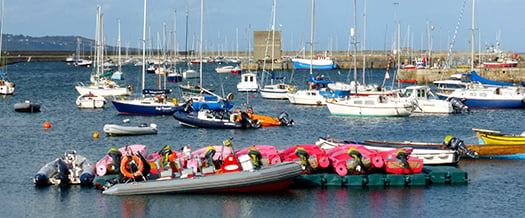
Space is so constrained that a floating dinghy park has to be used to store the smaller craft. Photo: W M Nixon
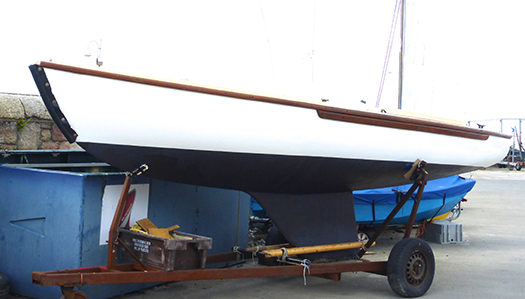
Thanks to the special INSS fendering devised by Arthur Rumball, this 35-year-old Squib has survived many seasons of tough teaching in good order. Photo: W M Nixon
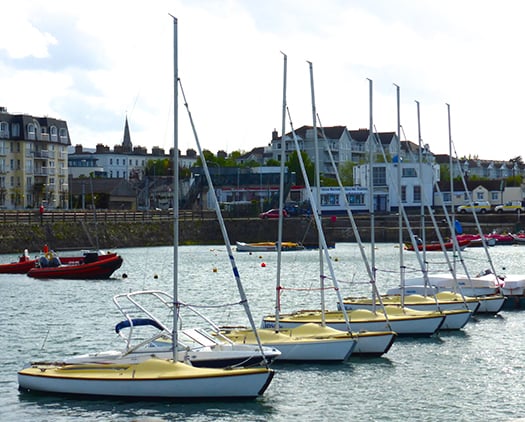
To economise on space, the Squibs berthed here, with the INSS building in the background, are double-moored. Photo: W M Nixon
Of which more anon, for this bare outline gives only a hint of the INSS's complex programme. The Rumball theme is that you have to keep operations and facilities flexible to cope with fluctuating demand, for at the height of the season the school is operating a fleet of 200 boats ranging from kayaks through sailing dinghies of increasing size, then on into keelboats of which some well-fendered Squibs are the workhorses while 1720s provide the glamour input, and finally at the top of the tree there's the Reflex 38 Lynx, bought from Galway this past winter, and becoming part of a programme headed by Alistair's son Kenneth – a Silver Youth Medallist in the 420 – who is now a fully-qualified offshore racing pro teacher, but also races the 1720s while being main operations director of a school which has five full–time employees, but in all has sixty staff at the height of the season.
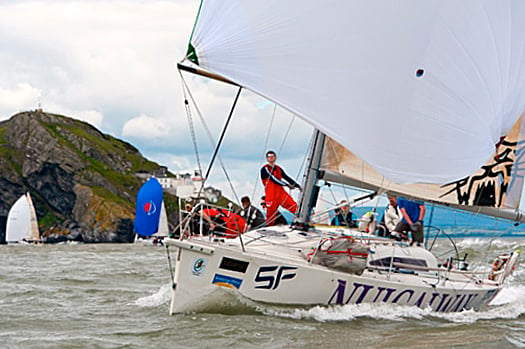
The latest addition to the INSS fleet is the Reflex 38 Lynx, seen here racing for NUI Galway during the Round Ireland. In 2015, Lynx has already scored a second overall in ISORA racing skippered by Kenneth Rumball.
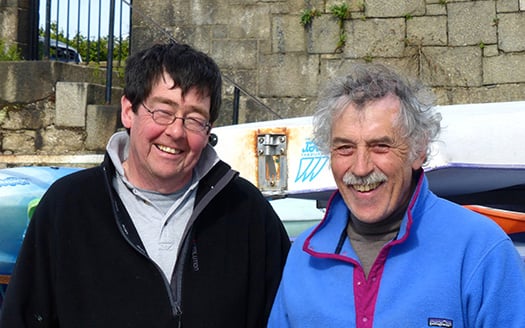
Brothers in business – seen here with his brother Alistair, Arthur Rumball (left) runs the often very busy INSS boat maintenance facility. Photo: W M Nixon
As to shoreside facilities, each summer they set up an additional seasonal summer base to the west of the West Pier with top-of the-line Portakabins at Salthill to provide facilities for those sailing dinghies and kayaks, and in addition the INSS have their own boat-maintenance unit under Arthur Rumball beside the boatyard in the Coal Harbour.
So an impressive amount of things have happened since 1978, the best of them surely being that Alistair persuaded Muriel, a country girl from one of the most beautiful parts of County Carlow, to marry him. For Muriel is a teacher by profession, and adept at being the peace-maker who smooths the waters after Alistair has been making waves, which even now still seems to be just about all the time.
That said, he gives the impression of having so many chips on his shoulder about the perceived opposition to his ventures by those in authority that you begin to think it might be just a bit of an act, for underneath it all he has a heart of gold, yet with the spirit of a lion who will fight the good fight to defend his territory and the interests of his family, friends, trainees and businesses.
The quality of the man was well revealed when the economic recession struck. At the height of the boom years, the Irish National Sailing School had a throughput of more than 2,500 people per month coming new to sailing, and it had become a vibrant and trendy part of the recreational fabric of good-time Dublin. Then around 2008, the economy went into free-fall. But the INSS survived both by making severe cutbacks in everything, and utilising another string in Alistair's bow.
Because of his ready enthusiasm to undertake just about everything and anything to do with boats, back in 1982 he'd looked after some waterborne scenes with classic small craft for the Channel 4 TV comedy-drama series The Irish RM, starring Peter Bowles and Bryan Murray, which went out between 1983 and 1985. It was grand at the time, but thirty years down the line it now seems to have a dose and more of the Paddywhackery about it. However, that was neither here nor there for Alistair Rumball in 1982, for it gave him a lucrative little sideline, and over the years since he has been the man to go to if you want to set up boats and sailing ship scenes in the Irish movie-making business.
So it's ironic, when we remember that Malahide was where the rather mouldy old Vikings of Dublin made their last base after their city had been captured by the Normans in 1171, that it should be a Malahide boy who has emerged as the behind-the-scenes captain of ships for the filming of the blockbuster series Vikings.
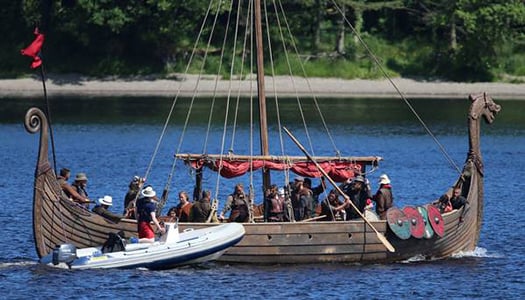
When you've spent most of your working life teaching people to sail, tutoring Thespian Viking crewmen on a Wicklow lake is just an ordinary part of another day at the office.
It has all been happening for some years now up in the Wicklow mountains and out on the Wicklow lakes, which have passed themselves off very well as Norwegian fjords, yet can double quite effectively as the coastal and riverside scenery of the many places where the Norwegian Vikings wreaked mayhem.
Who knows, but maybe with the passage of time the epic Vikings series will come to be seen as the epitome of Scandiwhackery, but for now, it certainly does the business . For as the Irish economy fell off a cliff, Alistair Rumball soared aloft in creating, managing, and manoeuvring a very authentic and substantial Viking longship flotilla which has provided a proper Tinseltown income to make all things possible, while helping underwrite the future of the Irish National Sailing School.
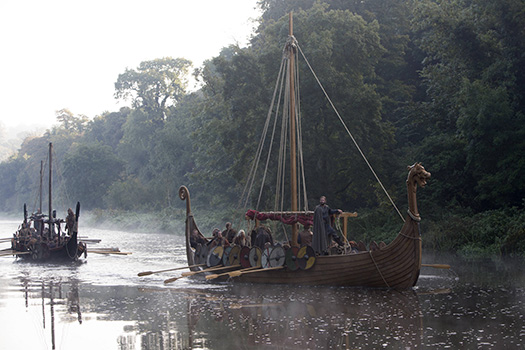
Lough Dan in County Wicklow - where Erskine Childers first sailed around 1890 – has proved remarkably versatile in providing backgrounds for the Vikings which could either be Norway itself, or else the shores of places they are raiding
But it's extraordinarily demanding and time-consuming work, even if he has a staff of 150 specialists up in the Wicklow hills, and after a year or two it became clear that he was trying to do too much. So four years ago his son Kenneth, who is now 27 and was at the time working as an accountant, moved in to take over the direction of the sailing school, and as the recession has started to recede – last year they had monthly numbers pushing back towards the 2,000 mark - Kenneth's energetic and all-encompassing input is seeing the school increasing the scale of its operations, particularly in what might be called the post-graduate side with the development of 1720s at top race level. Now the acquisition of Lynx has developed things further - she has already made what was a rather hasty debut in the first ISORA of the year, but despite being only minutes out of the box, they placed second overall, and that only by six minutes.
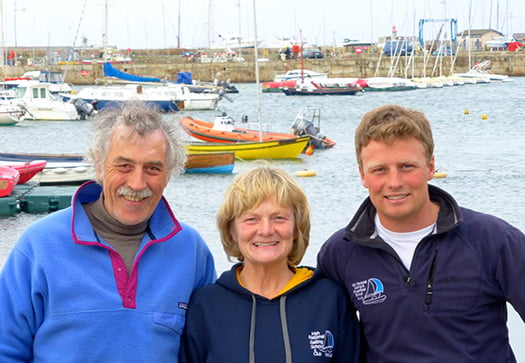
Alistair, Muriel and Kenneth Rumball. Photo: W M Nixon
This placing of racing as a natural part of the INSS syllabus has in turn led to the need for an officially-constituted club to comply with race entry requirements. But in reality the INSS has had a genuine club atmosphere for years, indeed it has more of a truly club-like atmosphere than many a historically-constituted old yacht club. So it was only a formality to bring the Irish National Sailing Club into being in January 201, but it's for real, here's a pic of the Committee of the new club meeting in the old Tom Walsh building on Monday, and if you want to join, it will cost you the outrageous sum of €10.
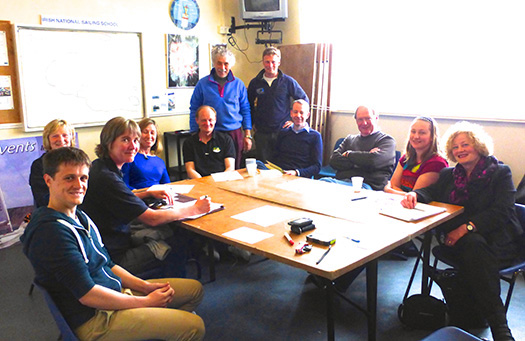
The committee and school management of the newly-formed Irish National Sailing Club are (left to right) Glyn Williams (foreground), Muriel Rumball, Joan Sheffield, Caroline Herron, Robin Jones, Alistair Rumball, Kenneth Rumball, Garrett O'Malley, Dermot Igoe, Heather Blay and Mary Beck. Photo: W M Nixon
As to how Alistair Rumball views the impending possible re-structuring of Dun Laoghaire as a cruise liner port, with inevitable limitations on the amount of sailing which can take place within the harbour, he is both an idealist and a realist.
Like many of us, he dearly wishes that this splendid granite creation could be seen as a cherished part of our heritage, not as something to be used to generate income to turn a crude profit or even just to pay its own maintenance costs. Rather, we'd ideally like to see it treated as a national asset to provide vital recreational space for everyone afloat and ashore.
But Alistair Rumball senses that the government's determination to use just about everything in public ownership to generate income will win the day, and he is already being realistic about what the regular if summer-emphasised arrival of cruise liners will mean.
In fact, he may even derive a certain sardonic satisfaction from seeing the Dun Laoghaire sailing establishment having to contemplate accepting conditions with which his school has complied ever since he began operating it.
"People should realise" he asserts, "that there are already two clearly-define shipping channels in Dun Laoghaire Harbour. One is from the harbour entrance to St Michael's Wharf, which will simply be retained if the cruise liners come. The other, much less widely known, is supposed to be from the harbour entrance to the berth at the Band Stand on the East Pier. Even at present, you are not meant to operate under sail in either of those channels, but an awful lot of boats do so."
"However, as we are a commercial operation, we have a strict policy of complying with regulations and carrying out our sail training and teaching operations in the western part of the harbour, clear of the main channel. So a cruise liner should not affect our in-harbour activities, while our larger craft going out into the bay will have to comply with shipping regulations in the entrance like everyone else".
Whatever happens, we may be sure that the Irish National Sailing School and the Irish National Sailing Club - and their splendid founder - will continue to be a thorn in the side of those who take themselves too seriously and have an inflated idea of their own importance. But if you've never been in a boat before and know nobody in sailing, yet feel a growing enthusiasm to go sailing in Dun Laoghaire, you now know where to go to experience the real thing.
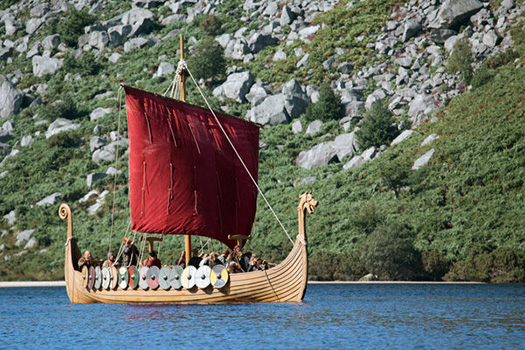
The other side of the INSS show – a Viking ship looking good on Lough Dan
#dlharbour – The 1083–foot Royal Princess Cruise Liner that anchored in Scotsman's Bay was welcomed at Dun Laoghaire Harbour on schedule this morning, just after 6am. It is the first cruise ship of the season to arrive at Dun Laoghaire and had sailed overnight from Cork Harbour into the Bay. It will remain off Dun Laoghaire Harbour all day, departing at 6pm.
No sooner had the 217–foot high Royal Princess dropped anchor approximately one kilometre east of Dun Laoghaire's East Pier lighhouse than the ship began disembarking some of its 5,000 passengers and crew by tender at 0630 hours.
Just before 7am the first two orange coloured tenders reached the harbour mouth escorted by a RIB flying a yellow flag.
A welcome programme for the Royal Princess will be staged in the seaside town today aimed at increasing visitor interest in Dun Laoghaire, a Dublin suburb located 13km (8miles) south-east of the City Centre.
2015 is set to be the most successful cruise season for Dun Laoghaire, with an expected 100,000 passengers and crew expected to arrive into the Harbour over the next five months. A total of 21 calls will be made to Dun Laoghaire Harbour, with many of the ships involved bringing in more than 5,000 passengers and crew. The Royal Princess is a brand new next generation vessel and was launched in 2013.
This morning's Dun Laoghaire visit follows yesterday's one day stop-over of the MSC Splendida into Dublin Port, the biggest ship ever to visit the city centre.




























